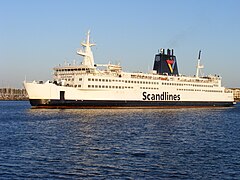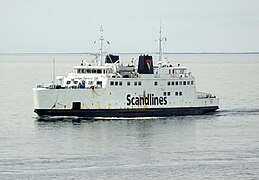Scandlines
| Scandlines Germany GmbH
|
|
|---|---|
| legal form | GmbH |
| founding | 1998 |
| Seat | Hamburg , Germany |
| management | Heiko Kähler
Gerald Lefold |
| Number of employees | approx. 1500 (seasonal) (2016) |
| sales | 477 million euros (2018) |
| Branch | Shipping (ferry route operator) |
| Website | www.scandlines.de |

The Scandlines Germany GmbH , based in Hamburg is a German-Danish shipping company , the two Baltic operates -Fährrouten between Germany and Denmark. It is a subsidiary of Scandferries Holding ApS with headquarters in Copenhagen (Denmark).
The Scandlines logo is a symbol for Scandlines' most important markets. Yellow stands for Germany , red for Denmark and blue for Sweden .
From 2013 the company 3i was the sole owner of the shipping company. At the end of March 2018, 3i sold the ferry company for 1.7 billion euros to a consortium made up of the asset managers First State Investment and Hermes Investment Management . 3i then again acquired 35% of the shares in the shipping company, the Australian company First State Investment holds around 50% and the British company Hermes Investment Management 14.9% in Scandlines.
History and corporate structure

The history of the ferry activities of the German railway companies between Germany and Scandinavia goes back to 1903, when the first railway ferry connection between Warnemünde (Germany) and Gedser (Denmark) was opened. In 1909 the first rail ferry service between Germany and Sweden followed, the " King's Line " between Sassnitz (Germany) and Trelleborg (Sweden).
With the opening of the " Vogelfluglinie ", a ferry connection between Puttgarden (Fehmarn Island) and Rødby ( Lolland Island in Denmark), the cooperation between the two ferry companies in Denmark and Germany was further deepened in 1963.
The Deutsche Fährgesellschaft Ostsee (DFO) was founded in 1993 as a company under private law as part of the merger of the former East and West German railway companies - Deutsche Reichsbahn (DR) and Deutsche Bundesbahn (DB).
The Danish State Railways (DSB) annexed in 1997 its ferry business in the Scandlines Danmark A / S from.
In 1997 DFO and Scandlines invested in the expansion of the Vogelfluglinie, u. a. in the modernization of the port facilities and in the construction of four modern double-ended ferries ( Germany , Schleswig-Holstein , Prinsesse Benedigte , Prins Richard ).
In 1998 the German shipping company DFO merged with the partner shipping company Scandlines Danmark A / S (today Scandlines Danmark ApS )
Deutsche Bahn AG and the Kingdom of Denmark, represented by the Ministry of Transport , remained the owners . In the years that followed, Scandlines continuously expanded its international route network, for example by opening new ferry connections to the Baltic States and Finland.
In 2007 the owners sold their shares to the financial investors 3i and Allianz Capital , who each took over 40 percent, and to Deutsche Seereederei GmbH (DSR) from Rostock, which took a 20 percent stake. On November 6, 2008, Scandlines AG was converted into Scandlines Deutschland GmbH (today's headquarters in Hamburg).
On October 29, 2010, DSR announced that it would sell its 20% stake in Scandlines in equal shares to the financial investors 3i and Allianz Capital Partners (ACP).
In spring 2010, Scandlines ordered two new large hybrid ferries (order volume for new buildings and adjustments to the ferry ports 230 million euros) from P + S Werften GmbH ( Volkswerft Stralsund ). After the shipyard had considerable difficulties building the two ships Berlin and Copenhagen , Scandlines canceled the contracts. The P + S shipyards had to file for bankruptcy. Scandlines later bought the ships from the bankruptcy estate, which had not been accepted because they were too heavy, and had them converted by the Danish shipyard Fayard A / S in Munkebo . The ferries were put into service in May and December 2016. They now operate on the Rostock – Gedser route and are currently the largest hybrid ferries in the world with a length of 170 meters each and space for 1,300 passengers and 460 cars or 96 trucks.
In 2012 Scandlines sold the Travemünde – Ventspils / Liepaja, Nynäshamn – Ventspils, Rostock – Trelleborg and Sassnitz – Trelleborg routes to Stena Line . In addition, the Rostock – Hanko route and the Merchant , Aurora and Urd ferries were sold to the Swedish Orient Line (SOL).
In 2013, the British investment firm bought 3i the Scandferries Holding ApS and was until 2018 the sole owner of Scandlines Germany GmbH .
The short ferry line from Helsingør (Denmark) to Helsingborg (Sweden), operated together with Stena Line from 2000, was sold to First State Investments retrospectively as of January 1, 2015, including the five ferries operating here (two of them from Scandlines) . The HH Ferries Group continued to operate this line under the Scandlines Helsingborg – Helsingör brand until 2018. In 2018, the ForSea company was renamed, and the ships have no longer operated under the Scandlines brand.
On June 7, 2017, the two Scandlines routes Puttgarden - Rødby and Rostock - Gedser were temporarily suspended due to an unspecified bomb threat. Although the Helsingør – Helsingborg route was no longer part of Scandlines, ferry traffic was temporarily suspended here as well, as the threat was not related to a specific route and the ships were still operating under the Scandlines brand.
In 2016, Scandlines transported 7.6 million passengers, 1.8 million cars and 0.6 million freight units on the two routes Rødby – Puttgarden and Gedser – Rostock. In 2019 there were 7.2 million passengers, 1.7 million cars and more than 0.7 million freight units with a total of 41,500 departures with eight ferries.
In the ports of Puttgarden and Rostock, Scandlines operates two “BorderShops” with a wide range of alcoholic and non-alcoholic beverages and sweets, with which in 2016 almost 30 percent of the company's sales were achieved.
Key figures of the corporate group
| year | Sales in million euros | Operating result in million euros | Annual surplus in million euros | Employee | Passengers in millions |
|---|---|---|---|---|---|
| 2007 | 589.6 | 2,945 | 20.5 | ||
| 2008 | 584.0 | 131.0 | −20 | 2,729 | 17.3 |
| 2009 | 504.9 | 159.0 | −5 | 2,604 | 12.0 |
| 2010 | 567 | 177 | 22nd | 2,442 | 12.4 |
| 2011 | 611 | 182 | 10 | 2,177 | 12.0 |
| 2012 | 608 | 76 | 2.112 | 11.7 | |
| 2013 | 505 | 172 | 1,772 | 11 | |
| 2014 | 445 | 160 | 60 | 1,533 | 11.1 |
| 2015 | 460 | 170 | 107 | 1,488 | 7.6 |
| 2016 | 470 | 180 | 81 | 1,506 | 7.6 |
| 2017 | 487 | 194 | 88 | 1,524 | 7.6 |
The figures were taken from Scandlines' current annual reports and press releases.
Ferry routes
- Puttgarden ( D) - Rødby ( DK ): Railway and car ferry (" Vogelfluglinie ")
- Rostock (D) - Gedser (DK): Car ferry
fleet
As part of the company's own strategy “From hybrid to emission-free ferries”, the Prinsesse Benedektiven ferry on the Puttgarden-Rødby route was the first to be converted to a hybrid ferry in 2013. In 2014 the remaining three ships on the route followed. The ferries are now powered by a hybrid system that combines the traditional diesel engine with an electric battery drive . Excess energy is stored in batteries that drive the electric drive motors. In this way, the ferries can reduce their fuel consumption and better adapt them to the load. According to the shipping company, this will save up to 15% of CO 2 emissions. At the same time, the ships were equipped with an exhaust gas washer (scrubber), which reduces the gaseous pollutant emissions of the ferries by 90%.
At the same time, the hybrid ferries Berlin and Copenhagen were built for the Rostock – Gedser route and put into service in 2016. Compared to conventional ferries, the hybrid drive system of the two ferries can reduce fuel consumption by 2/3 per crossing. The Copenhagen was also equipped with a rotor sail in May 2020 in order to reduce CO 2 emissions by a further 4–5%.
Today six out of eight of the shipping company's ships are hybrid ferries; Scandlines thus owns and operates the largest hybrid fleet in the world in 2017.
-
 Berlin (Rostock – Gedser; hybrid)
Berlin (Rostock – Gedser; hybrid) -
 Copenhagen (Rostock – Gedser; hybrid)
Copenhagen (Rostock – Gedser; hybrid) -
 Germany (Puttgarden – Rødby; Hybrid)
Germany (Puttgarden – Rødby; Hybrid) -
 Schleswig-Holstein (Puttgarden – Rødby; hybrid)
Schleswig-Holstein (Puttgarden – Rødby; hybrid) -
 Prinsesse Benedigte (Puttgarden – Rødby; Hybrid)
Prinsesse Benedigte (Puttgarden – Rødby; Hybrid) -
 Prins Richard (Puttgarden – Rødby; Hybrid)
Prins Richard (Puttgarden – Rødby; Hybrid) -
 Kronprins Frederik (Puttgarden - Rødby, Rostock – Gedser, reserve ship)
Kronprins Frederik (Puttgarden - Rødby, Rostock – Gedser, reserve ship) -
 Holger Danske (Puttgarden – Rødby, only dangerous goods)
Holger Danske (Puttgarden – Rødby, only dangerous goods)
Others
The company is a member of the ShortSeaShipping Inland Waterway Promotion Center .
In addition to the ferry lines, Scandlines operates two shopping centers under the name "Border Shop" in the ports of Rostock and Puttgarden (the latter on a multi-storey pontoon construction), which offer alcoholic beverages in particular for the Scandinavian tourist target group.
literature
- Scandlines records record number of passengers . In: Schiff & Hafen , issue 8/2016, p. 53, DVV Media Group, Hamburg 2016, ISSN 0938-1643
Web links
- Scandlines
- Overview of ships from Scandlines (Swedish)
Individual evidence
- ↑ Scandlines-Reederei has new owner , on ndr.de, from March 26, 2018. Accessed April 3, 2018.
- ↑ http://www.scandlines.se/om-scandlines/batteridrivna-farjor.aspx
- ↑ a b homepage. Scandlines, accessed September 14, 2017 .
- ↑ Scandlines sells freight business. Fehmarn24.de, accessed on April 21, 2020 .
- ↑ Scandlines completes sale of freight routes , on rostock-heute.de, accessed on April 21, 2020
- ↑ Scandlines completes sale of Helsingør-Helsingborg ferry route , on gemo-netz.de, accessed on April 21, 2020
- ↑ Fprsea puts the world's largest battery ferry into operation. November 14, 2018, accessed November 17, 2018 .
- ↑ POL-HL: OH-Puttgarden-Fährhafen / bomb threat on Danish ferries - final report. Police Directorate Lübeck, June 7, 2017, accessed on June 8, 2017 .
- ↑ Jens Kiffmeier: Normal operation at Scandlines . In: Daily port report from June 11, 2020, p. 16
- ↑ a b Scandlines focused on its core business in 2015 and invested in the future. Press release. Scandlines, May 20, 2016, accessed on January 19, 2019 ( list of annual reports ).
- ↑ Scandlines more competitive than ever after a strong 2016. Press release. Scandlines, May 18, 2017, accessed September 14, 2017 .
- ↑ Scandlines achieves record results in 2017 after expanding its capacity. Press release. Scandlines, April 25, 2018, accessed February 13, 2019 .
- ↑ Rotor sails on the "Copenhagen". Scandlines, accessed June 25, 2020 .
- ↑ Scandlines installs rotor sails from Norsepower on board the hybrid ferry “Copenhagen”. Press release. Scandlines, August 14, 2019, accessed August 28, 2019 .
- ↑ Border Shop , on scandlines.de, accessed on July 18, 2019
- ↑ The Bordershop in Puttgarden , on reisecenter-fehmarn.de, accessed on July 18, 2019








